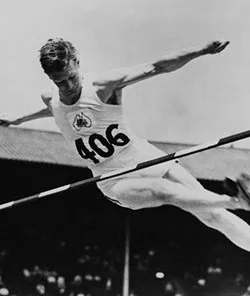
One of the major surprises of the 1948 Olympic Games was the gold medal won by Western Australian high jumper John Winter.
When the Olympic Games resumed after a 12 year hiatus due to World War II a then record fifty nine countries took part. Australia had its largest athletics contingent to date with fourteen athletes and would finish with five medals.
John Winter was born in Perth and educated at Scotch College where he became high jump champion. He went to work in a bank after leaving school but at 18 years of age enlisted in the air force, trained as a pilot and earned his wings. He was later posted to England where he remained until the end of the war.
John returned to Australia in 1946, resuming his athletics career, clearing 6’4” (1.94m) in Perth in November. The 1947 Nationals were the first since 1937 and were held at Leederville Oval, Perth in January. He easily won the high jump with 6’6¼” (1.99m) by 11cm over decathlete Peter Mullins. He then improved his new Australian record to 6’7” (2.007m) in February.
The 1948 Nationals were held on the St Kilda Cricket Ground, Melbourne in January and John retained his high jump title quite easily with 6’6” (1.99m). In Perth a month later he raised his national record to 6’7¼”(2.01m). He was chosen for the 1948 Olympics, but in the face of a big problem for all selected athletes – finance.
The entire team, across all sports, was ranked with athletes required to help raise money to send it to the Games. The money raised would then go to the next ranked athlete on the list so an athlete ranked lowly would be raising money for athletes ranked above them in the hope that enough money would be raised to eventually get them sent. John did a lot of fund-raising, travelling around with Shirley Strickland so both could get to London.
The Australian team with John and Shirley included, eventually got away by air (they returned by sea). The high jump was on the opening day of the athletics events held at the famous soccer stadium at Wembley. He would now have the opportunity to jump from a cinder surface and land in sawdust unlike back home jumping from grass. John used the antiquated technique of the eastern cut-off, which had a small layout across the bar, a modified version of the scissors technique.
Transport to Wembley Stadium was haphazard so John and athletics team manager Jack Metcalfe (1936 Olympic triple jump bronze medallist) hitched a ride from Willesden Technical School where they were billeted three miles from Wembley. The qualifying round was held in the morning and the final in the afternoon. The qualifying height of 6’1½” (1.87m) managed to eliminate six competitors, leaving twenty athletes in the final.
John was not expected to beat the Americans but all jumpers had difficulty with the takeoff as it became soft. US trials winner Verne McGrew was in trouble early and could only clear 1.80m to finish sixteenth. Five athletes cleared 6’4¾” (1.95m) including John. However he had cleared it on his second attempt and was behind on the count back, leaving Bjorn Paulsen (Norway) in the lead ahead of Americans George Stanich and Dwight Eddleman and Frenchman Georges Damitio. At 6’6” (1.98m) John cleared first time but felt pain and he thought he had ‘ricked’ his back.
He then had to sit and wait whilst the other four tried to clear the height. Fortunately the others could not, so John was not required to jump again and test his painful back, which as it turned out was due to dehydration and not any muscular problem – the result of John remaining at the stadium after the qualifying round and not taking in any fluid.
John later said that he would have continued to jump if he had needed to and he claimed that evening to have made up for the lack of drink when celebrating.
As of 2008, John’s triumph has proven to be Australia’s only Olympic gold medal in the high jump with ‘Chilla’ Porter coming close with silver in 1956 and Tim Forsyth bronze in 1992 and the country’s last Olympic field event victory until Steve Hooker’s pole vault win in Beijing
John did not compete in the 1949 Nationals in Sydney but returned for the 1950 edition in Adelaide winning with 6’4” (1.93m) and was selected for the Empire Games to be held in February in Auckland.
The athletics at the Games were held on the famous rugby ground at Eden Park. The high jump was on the first day of athletics and seventeen competitors began jumping, all clearing 5’9” (1.75m). As the bar moved up and others dropped out, five athletes were left attempting 6’5” (1.955m). Peter Wells (England) failed but John, Josiah Majekodunmi (Nigeria), Alan Paterson (Scotland) and John Borland (New Zealand) went clear. However at the crucial height of 6’6” (1.98m) as in London two years before, only John survived to take gold.
His life as a high jumper came to an end after Auckland. This was not unusual in those days for athletes to have short sporting careers, as there was no money in amateur sports and athletes had to make a living.
John retained a strong interest in the Olympic movement and in athletics, before passing away in late 2007.
Paul Jenes
AA Statistician
President ATFS
Acknowledgements.
Harry Gordon, Australia and the Olympic Games
Paul Jenes, Fields of Green, Lanes of Gold
Rob Whittingham, Stan Greenberg, Paul Jenes, Athletics at the Commonwealth Games
Paul Jenes, Peter Hamilton, Australian Athletic Results
Mark Butler, Olympic Athletics Statistics

